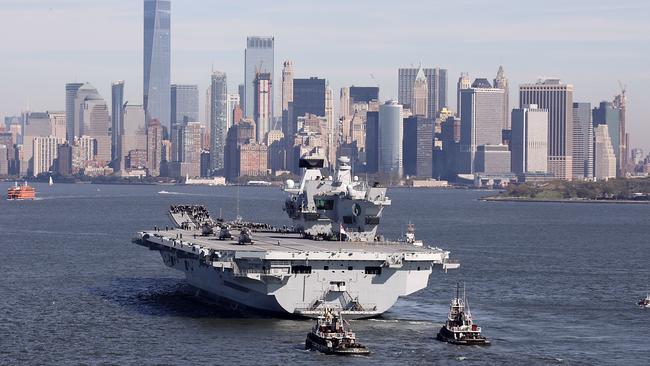Trump must look to allies if he’s to stare down belligerent China
Washington must deepen its alliances in Asia to constrain Beijing’s maritime militarisation.

The winds of trade and the winds of war mingle in the South China Sea. Donald Trump’s across-the-board showdown with Xi Jinping now takes in the development of new weaponry, a hoovering up of cyber-intelligence and an escalating trade conflict that the US President once promised would be an easy victory. Yet it is in the maritime lanes through the scrappy islands and atolls at China’s doorstep where the battle between the old West and the rising East is being conducted most nakedly. Prepare for the war at sea.
Presidents from Richard Nixon to Barack Obama have clung to the idea an increasingly prosperous China would liberalise economically and politically. Admitting it to the World Trade Organisation would usher in new openness and render it a safe, well-integrated member of the global order. Instead Chinese dictatorship has deepened, it runs a surveillance state and it ransacks the world’s intellectual property.
Obama said the US had more to fear from a weakened paranoid China than from a successful, booming one. Trump has thrown these assumptions overboard. His point is to compete with China (and Russia) rather than convert it. On trade, he is turning the screws: he plans to raise tariffs on $US200 billion ($282bn) of Chinese imports from 10 per cent to 25 per cent by early next year. There could even be levies on another $US267bn of Chinese goods.
That would be a full-blown trade war and its crudest by-product, as in the British rivalry with the up-and-coming Kaiser’s Germany, is naval confrontation along trade routes.
By 2030, intelligence services calculate, the Chinese navy will have 415 ships. The US navy, under its present plans, should have about 300. As for Britain, it seems it’s going to support the US in keeping the South China Sea free for navigation even if that means clashing with China. That was the symbolic point of the aircraft carrier HMS Queen Elizabeth docking in New York on Trafalgar Day this week. “Global” post-Brexit Britain will promise to play its part in ensuring that the sea is governed by international law rather than by Chinese fiat.
That meant sending the amphibious carrier HMS Albion, carrying a contingent of Royal Marines, close to the Chinese-occupied Paracel islands in August: a Chinese frigate came in close and mounted a challenge. This month, a US vessel had a similar brush with a Chinese warship. The head of the Royal Navy, Philip Jones, says Britain will carry on. But there is some unease as to how aggressive the Chinese will become when the next American tariff rise takes effect.
China profited from the peace in Asia that stemmed from the setting up of US bases in the region after the end of World War II and the Korean War. Under Xi, however, it has come to see the US presence as a form of encirclement. This sense of being boxed in is what China has in common with Russia and Iran. They all feel that they have been squeezed out of their rightful place as regional leaders by US power that skews the global rules against them and then upholds those rules with the brute force of a hi-tech navy.
The South China Sea is where Beijing is ready to fight back, because of its vulnerability there. About $US3 trillion worth of seaborne trade threads through the waterways. In May a US admiral conceded China could exercise control there “in all scenarios short of war with the US”. Beijing creates artificial islands and landing strips. Three of the largest reefs have been turned into a strategic triangle.
A trading conduit has been militarised. Jack Ma, head of Alibaba, the huge Chinese e-commerce concern, says: “If trade stops, war begins.” That echoed a fundamental view of the Chinese communists, who see expansion of markets and expansion of military power as being on a spectrum. Trade wars do not inevitably lead to armed conflict. China’s island fortress-building could be about creating a zone between war and peace, a way of scaring off smaller players or raising the cost of US intervention.
But trade rows almost always mask a deeper conflict. In 1937, the US clashed with Japan over its cheap cotton textiles. Japan thought that the broader exclusion from US markets was just another way of saying it should remain a minor global presence. It built up a naval presence in the Pacific, invaded French Indochina, faced a punitive US trade embargo in 1941 and five months later Pearl Harbor was hit.
Could it happen again? Caitlin Talmadge of Georgetown University has gone through some ways in which war by miscalculation could erupt in the South China Sea. In the misidentification, say, of a Chinese sub blockading the crowded Taiwan Strait; if the US navy collided or fired at a Chinese nuclear sub thinking it was a conventional vessel, it could be the first rung in an escalation ladder.
With China set to win numerical superiority in the South China Sea over the coming decade, the risks increase. The rational course, as China breaks international rules and obeys only those sufficiently vague to give it freedom of action, is to build multinational alliances with those countries that feel most exposed to Chinese pressure. That is: Japan, South Korea, Malaysia, Vietnam, all big growing markets that are rightly nervous about their big neighbour. The Trump administration needs to understand the strength of regional alliances as it faces off with China, the increasingly brazen insurgent power.
The Times


